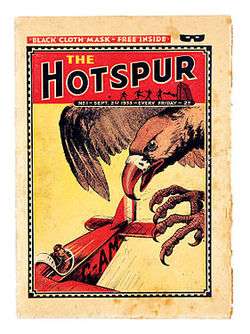The Hotspur
| Hotspur | |
|---|---|
|
Issue 1 of Hotspur (1933) | |
| Publication information | |
| Publisher | D. C. Thomson & Co. |
| Genre |
|
| Publication date | 2 September 1933 |
The Hotspur was a British boys' paper published by D. C. Thomson & Co. From 1933 to 1959, it was a boys' story paper; it was relaunched as a comic in 1959, initially called the New Hotspur, and ceased publication in January 1981.
The original Hotspur
The Hotspur was launched on 2 September 1933[1] as a story paper, the last of the 'Big Five'.[2] The first issue came with a black mask as a free gift[3][4] and contained an offer for an electric shock machine:
It's a great prize, absolutely harmless and will give hours of fun. Just watch your pal's face when you give him his first electric shock![5]
Thomson's 'Big Five' papers were extremely successful; the name was used by both readers and the industry.[6][7] In 1939 the company advertised combined weekly sales of over a million for the group; the first issue of The Hotspur sold over 350,000 copies.[8] The Hotspur specialised in school stories;[9] its Red Circle School stories replaced the public school stories in The Gem and The Magnet as reader favourites.[10][11]
Like other British children's publications, The Hotspur was published weekly, except for the Second World War and its aftermath, when as a result of paper rationing it published fortnightly,[12] alternating with The Wizard.[13] The original Hotspur story paper published 1197 issues, the last on 17 October 1959.
Notable characters and series
- Red Circle School, a public school with pupils from all over the world.[14][15]
- Bill Sampson, also known as The Wolf of Kabul, an agent of the British Intelligence Corps, first introduced in The Wizard, appeared in illustrated format in The Hotspur.[16]
The New Hotspur
It relaunched in comic format as the New Hotspur[17] on 24 October 1959, a week after the original series ceased publication, and ran for another 1110 issues until being incorporated into The Victor on 24 January 1981.[18][19] The new format contained comic strips as opposed to the old text story format. The word "new" in the title was dropped with issue #174. There had been several mergers during the 1970s: with The Hornet in 1976, and with The Crunch in 1980. In January 1981 The Hotspur finally merged with The Victor.[18]
Strips included:
- Coral Island
- Jonny Jett
- King Cobra, journalist Bill King transforms into the UK's very own high-tech superhero. Drawn by Ron Smith.
- Spring Heeled Jack
- Union Jack Jackson, a British Royal Marine serving with the US Marine Corps in the Pacific campaign during World War II, later in Warlord.[20]
- X-Bow
References
- ↑ Vic Whittle, British Comics.
- ↑ Joseph McAleer, Popular Reading and Publishing in Britain 1914–1950, Oxford: Clarendon, 1992, ISBN 0-19-820329-2, p. 168.
- ↑ British Book News 1979, p. 296.
- ↑ Winter 2004 Market Report, Compalcomics.
- ↑ McAleer, p. 179.
- ↑ McAleer, p. 168. In addition to The Hotspur they were Adventure, The Rover, The Wizard and The Skipper.
- ↑ Roger Sabin, Comics, Comix & Graphic Novels: A History of Comic Art, London: Phaidon, 1996, ISBN 0-7148-3008-9, p. 44: "These papers in the 1920s and 1930s were dominated by the 'Big 5'.
- ↑ McAleer, p. 172, note 18; p, 172, Fig. 6.1.
- ↑ William Oliver Guillemont Lofts and Derek John Adley, The Men Behind Boys' Fiction, London: Howard Baker, 1970, ISBN 0-09-304770-3, p. 9.
- ↑ McAleer, p. 169.
- ↑ Jeffrey Richards, Happiest Days: The Public Schools in English Fiction, Manchester University Press, 1988, ISBN 0-7190-1879-X, p. 289: "In its heyday The Magnet had a weekly press run in excess of 200,000. By 1930 it had fallen to 120,000 as a result of the direct competition of D. C. Thomson papers. This became particularly serious in 1933 with the launch of The Hotspur and the appearance of Red Circle, a tougher, more rambustious and more up-to-date public school than Greyfriars . . . which wooed schoolboy readers away. . . . By 1940 the Magnet's circulation was down to 41,660 [while] Gem had by 1939 fallen to 15,800 copies a week".
- ↑ McAleer, p. 62.
- ↑ Hotspur at 26pigs.com.
- ↑ McAleer, p. 169.
- ↑ Dan O'Neill, "Wizard time to be a boy; Time to remember", South Wales Echo, September 17, 2001.
- ↑ Conroy, p. 158.
- ↑ Redesigned by its postwar editor, Jack Mackersie; McAleer, p. 163, note 3.
- 1 2 Vic Whittle, Hotspur Page at British Comics.
- ↑ Kevin Carpenter, Penny Dreadfuls and Comics: English Periodicals for Children from Victorian Times to the Present Day: a loan exhibition from the Library of Oldenburg University, West Germany at the Bethnal Green Museum of Childhood, 2 June-2 October 1983, London: Victoria & Albert Museum, 1983, ISBN 0-905209-47-8, n.p..
- ↑ Mike Conroy, War Stories: A Graphic History, New York: Ilex/Harper, 2009, ISBN 978-0-06-173112-9, p. 116
External links
- The Hotspur at the Grand Comics Database
- "Japers of the Red Circle", the Red Circle School story from The Hotspur issue number 1, at Vic Whittle's British Comics site
